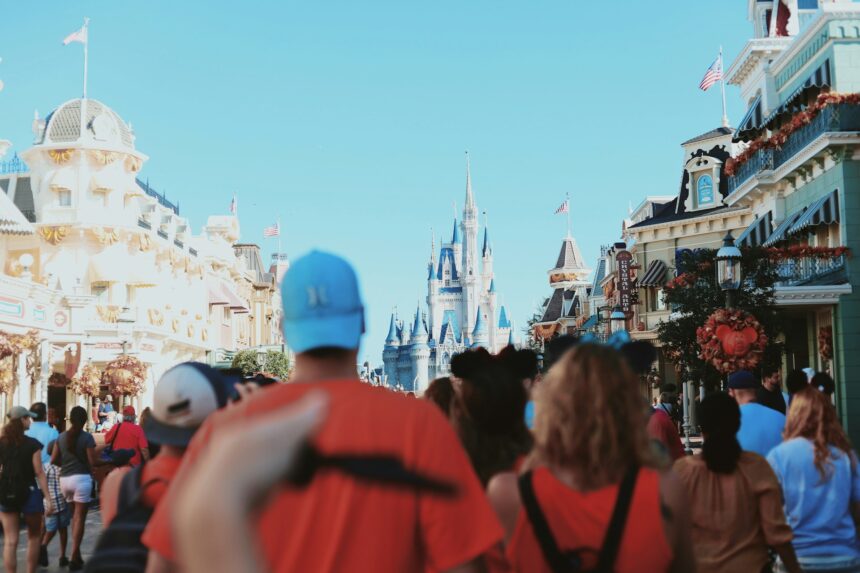Age is important for marketers. There are many social, cultural and personal differences between age-defined cohorts. Having said this, a strategy based on age is not always the best strategy for enduring profitable growth. Of course, there are products designed specifically for certain age-demographics such as diapers – baby and adult – or wrinkle creams. But, it is always wise to remember that one condition is inevitable: people become older and older. Brands must always both maintain customers and attract customers.
Having a reputation for being a brand for older folks may be very profitable for a while but new, younger users may avoid becoming customers. Although it is possible to span cradle to grave very few brands do this successfully. Disney is probably the single brand that crosses the cradle-to-grave expanse. No matter how adorable the toddler jean jackets, Baby Gap did not help The Gap. No matter how fabulous their music, having AARP sponsor the Rolling Stones Tour is cringeworthy.
And, lest we forget, the “Not Your Father’s Automobile” campaign for Oldsmobile only reinforced that the fact that the brand was for your father and his father.
This brings us to Harley-Davidson. Harley-Davidson’s strategy focuses on the brand’s core Boomer biker constituency and on big expensive touring bikes that Boomers buy. The CVO Street Glide and the CVO Road Glide start at US $44,499.
Harley-Davidson CEO, Jochen Zeitz continues to trust in a strategy aimed at expensive touring bikes where the average age of the buyer is “late 50s” meaning there are lots of Harley-Davidson owners well into their 60s and above.
Mr. Zeitz says that Harley-Davidson “dominates” the “most profitable categories.” OK, but making money off of a diminishing segment cannot remain a profitable approach. The Wall Street Journal has opined, “ Harley will ride or die with the graybeards.” In other words, Harley-Davidson is committed to selling bikes for aging Boomers who connected with the zeitgeist of Stanley Kramer’s 1953 Marlon Brando film “The Wild One” (considered to be the first outlaw biker film). Those Harley-Davidson riders are the aging Boomers who saw themselves in Dennis Hopper’s Peter Fonda’s and Terry Southern’s 1969’s “Easy Rider” which ”starred” three Harley-Davidson customized Hydra Glides. These are the aging Boomers who have compartmentalized the cultural disaster at Altamont Speedway where the Rolling Stones thought it was a good idea to have Hell’s Angels as security.
At some point, sooner rather than later, the Boomers buying the big, expensive touring bikes will stop squeezing themselves into their leather pants and hang up their leather jackets. Sure, these Boomers may still be listening to Steppenwolf’s Born to be Wild but the song will be on Spotify while maneuvering the golf cart.
As reported in The Wall Street Journal, when Jochen Zeitz was appointed CEO, he told analysts that the previous CEO’s strategy of model expansion while chasing new customers and markets added manufacturing complexity and “diverted attention from Harley’s profitable models.” Mr. Zeitz eliminated offerings aimed at entry-level riders. Mr. Zeitz’ strategy was and is to focus on “profit over growth.” This strategy is not, apparently, drawing riders into the Harley-Davidson franchise.
Focusing on a core customer base only works until it does not, just channel Jaguar. Jaguar’s marketing lesson is do not rely solely on the established, loyal customer base without seeking new customers. Jaguar’s reputation and reality of cars spending more time being serviced than driven forced the brand to sell to Ford. At the time, there was an extremely loyal user base but an extremely small user base. There were not enough users to maintain profitability, even though some drivers owned two Jags, one to drive while the other was in the service bay. Tried and true Jaguar owners hung in with the brand until the end. There were so few Jaguar owners left that the brand could have sent birthday cards to each one. To raise margins, Ford made Jaguars on the Taurus chassis. Stuck in traffic behind a Ford-made Jaguar which now had the rear end of a Taurus could bring you to tears. And so, there went Jaguar’s exotic, enticing design. Eventually, even the loyalists let go.
Although Mr. Zeitz says that people “age into” the Harley-Davidson brand, this “aging into” is risky business. And, for Harley-Davidson, the Hog appeal has never been about age. Harley-Davidson’s appeal was fundamentally about a mind-set, a values set, a personal spirit. Anyone at any age can have the Harley-Davidson soul. (As a note, this is what VW is advertising now in the US. “We shape its metal. You shape its soul.’)
A little bit of Harley-Davidson history.
In 1981, AMF (American Machine and Foundry, now defunct, but at the time a very large recreational equipment company) sold the Harley-Davidson brand for $80 million. The new owners, a group of thirteen investors led by Vaughn Beals and Willie G. Davidson (grandson of co-founder William Davidson), completely restructured and rejuvenated Harley-Davidson. Under AMF, Harley-Davidson endured severe cost cutting and produced poor quality machines, damaging Harley-Davidson’s reputation.
One of the key components of the Beals-Davidson brand revitalization of Harley-Davidson was Harley-Davidson’s now famous market segmentation. (The Harley-Davidson segmentation has been used many times in marketing lectures and presentations.) Harley-Davidson’s market segmentation helped spur one of the greatest periods of enduring profitable growth for the Harley-Davidson brand.
The Harley-Davidson market segmentation divided the customer (owners/riders) base into seven segments. The brand recognized that its customer base was not monolithic. In fact, there were a variety of people with different needs, lifestyles and opinions who loved, owned and rode the brand.
A 1998, AdWeek used Harley-Davidson’s segmentation to illustrate the fragmentation of American marketplaces. The journalist wondered whether this meant a brand would have multiple messages to different target audiences. (Today, we take this type of communication for granted as big brands do have multiple audiences receiving different messages across multiple media and devices. The marketing approach is called Brand Journalism and was pioneered at McDonald’s during the 2002-2005 turnaround.)
In the June 25, 2012 edition of Hog Happenings’ part 2, the full segmentation of Harley-Davidson riders and owners appeared, taken verbatim from an “official” Harley-Davidson handout distributed at an internal marketing and management course. The segmentation was described as “The Diversity of HARLEY-DAVIDSON Buyers.”
As a note, please keep in mind this segmentation was generated over 40 years ago, when the majority of Harley riders were male. Since then, Harley-Davidson has created communications and outreach to female bikers. Additionally, just because the segmentation was generated decades ago, reading the segment descriptions still sounds fresh and real. Even though brand-business segmentations need updating, it does not mean the segmentations should be completely overturned.
Importantly, the Harley-Davidson segmentation is not about age. A person could be any age to reflect one of these segments.
1) Sensitive Pragmatists (29%)
The largest segment of Harley owners tends to be blue-collar workers. They consider themselves easy going and practical. These owners take motorcycle riding seriously. They say, “You’d better know something about what you’re doing before riding a motorcycle.” They like the “high” of riding. They tend to be FL-series owners.
2) Laid Back Campers (24%)
Quiet and soft-spoken. That describes these Harley owners. This group likes to cruise, not speed or race. The also view their bikes as a way to get out of the city and in touch with nature. These bikers are patriotic: the “Made in America” label is their number one reason for buying a Harley. They tend to be Sportster owners.
3) Cool-Headed Loners (17%)
The loners consider a Harley motorcycle the perfect get-away vehicle to express their independence. They tend to be higher income “white collar” individuals. In their opinion the “Harley experience” is the ride itself. They describe Harley as a “fingerprint: you buy the basic cycle, then personalize it so no one else has one exactly like yours.” Loners also believe in “live and let live;” to them, riding a Harley reflects that attitude. They tend to be Softail owners.
4) Adventure-Loving Traditionalists (10%)
This market segment rides a Harley for its independence, freedom and adventure. These individuals love risk and seek thrills. Traditionalists consider new Harley-Davidson riders trendy and unappealing. Like the Laid Back Campers, this group believes the reason behind Harley’s great performance and quality is the “Made in America” label.
5) Classy Capitalists (8%)
Sometimes described as “Rich Urban Bikers” or “RUBS” this segment represents the traditional American success story – a class of winners. Famous stars are represented in this group; members are often 45 to 50 years old. Most promised themselves years ago they would reward themselves with a Harley-Davidson after making a certain amount of money. This group loves the attention they get when riding a Harley-Davidson. They tend to purchase Softails.
6) Cocky Misfits (7%)
This buyer enjoys its reputation as the ‘bad guy” and the “wild man.” These owners claim to have “tattoos with attitude.” The last thing they want is to be seen as stylish! They live for a chance to cut loose on their machine. The sound and speed of a Harley are important to this group. They’re always looking for an opportunity to “open it up.”
7) Stylish Status Seekers (5%)
The smallest Harley-Davidson market segment is young, stylish and elitist. This group tries to emulate the “famous stars” of the Classy Capitalists group. These riders say, “ Riding a Harley separates you and makes you stand out.” Like the Classy Capitalists, this group wants to be noticed. Harley aesthetics have the biggest appeal to this group. Owners liken a Harley bike to a vintage car –both are made for a ride on a sunny day.
As part of Mr. Zeitz’ continuing strategy, updating this incredible market segmentation would seem to be a necessity. Focusing on age was never a Harley-Davidson strategic imperative. The original segmentation shows the complexity of the Harley-Davidson core customer base as specific people with specific needs in specific occasions.
Of course, a brand needs to have a bulls-eye target group. But, there are other core customers whose needs and occasions also need to be satisfied. The big Harley-Davidson brand is not uni-dimensional. Harley-Davidson is a multi-faceted, multi-dimensional, multi-segmented, multi-layered brand.
Using age as the discriminator may not be the best way for Harley-Davidson to ride on its road to enduring profitable growth. The analysts, observers and commentators recently interviewed by The Wall Street Journal seem to believe that sidelining younger generations in favor of older ones is bad for the Harley-Davidson brand. The goal must be to maintain established core customers while generating new core customers.
Age may be a descriptor but it is not a definer.
Contributed to Branding Strategy Insider by: Joan Kiddon, Author of The Paradox Planet: Creating Brand Experiences For The Age Of I
At The Blake Project, we help clients worldwide, in all stages of development, define or redefine and articulate what makes them competitive at critical moments of change. Please email us to learn how we can help you compete differently.
Branding Strategy Insider is a service of The Blake Project: A strategic brand consultancy specializing in Brand Research, Brand Strategy, Brand Licensing and Brand Education
FREE Publications And Resources For Marketers
Post Views: 80










